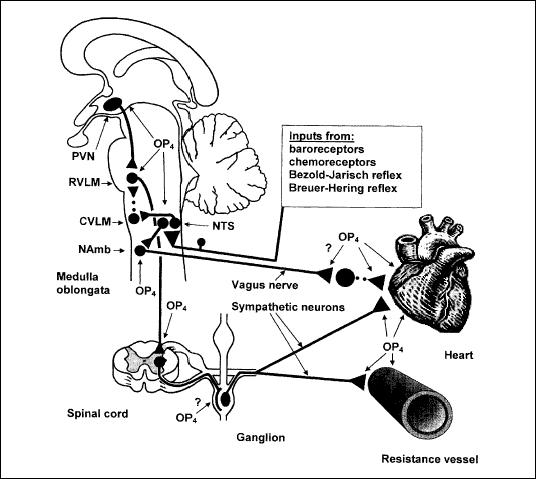Bezold-Jarisch reflex
Editor-In-Chief: C. Michael Gibson, M.S., M.D. [1]; Associate Editor-In-Chief: Cafer Zorkun, M.D., Ph.D. [2]
Synonyms and keywords: Bezold's reflex, Bezold-Jarisch response, Jarisch-Bezold reflex, BJR.
Overview
The Bezold–Jarisch reflex involves a variety of cardiovascular and neurological processes which cause hypopnea (overly shallow breathing or an abnormally low respiratory rate) and bradycardia (abnormally low resting heart rate).[1]. A cardiovascular depressor reflex involving a marked increase in vagal (parasympathetic) efferent discharge to the heart, elicited by stimulation of chemoreceptors, primarily in the left ventricle. This causes a slowing of the heart beat (bradycardia) and dilatation of the peripheral blood vessels with resulting lowering of the blood pressure. [2] [3] [4]
Historical Perspective
It is named for Albert von Bezold and Adolf Jarisch Junior.[5]. The concept was originated by Bezold in 1867, later revised by Jarisch in 1937.[6]
Physiology
- Bezold-Jarisch reflex is the occurrence of bradycardia and hypotension through a pathway involving cardiac receptors, medullary centers and vagal afferent nerves. Bezold-Jarisch reflex originates from inhibitory mechanoreceptors that are located in the left ventricle, particularly in the inferoposterior wall. The stimulation of these receptors occurs in the context of stretching and contraction of a poorly filled ventricle. Once stimulated, these mechanoreceptors stimulate parasympathetic pathways and inhibits the sympathetic pathways. The result of this reflex is a constellation of bradycardia, vasodilation and hypotension in addition to increase renin and vasopressin release.[6]
Clinical Implications
Bezold-Jarisch reflex plays a role in the following clinical conditions:
- Bradycardia, hypotension and gastrointestinal symptoms with inferoposterior myocardial infarction
- Exertional syncope in aortic stenosis
- Neurohumoral activation in chronic heart failure
- Reperfusion induced bradycardia and hypotension during coronary catheterization
- Therapeutic benefits of digitalis
- Vasovagal syncope[6]
Acute Posterior Myocardial Infarction
Bezold-Jarisch reflex is responsible for 61% of bradyarrhythmia that occur within the first hour of posterior MI. It is hypothesized that this reflex is a protective reflex that vasodilate the coronary arteries in the setting of posterior ischemia associated with coronary spasm.[7]
Prolonged upright posture results in some degree of pooling of blood in the lower extremities that can lead to diminished intracardiac volume. This phenomenon is exacerbated if the individual is dehydrated. The resultant arterial hypotension is sensed in the carotid sinus baroreceptors, and efferent fibers from these receptors trigger autonomic signals that increase cardiac rate and contractility. However, pressure receptors in the wall and trabeculae of the underfilled left ventricle may then sense stimuli, activating high-pressure C-fiber afferent nerves from these receptors. They may respond by sending signals that trigger paradoxical bradycardia and decreased contractility, resulting in additional and relatively sudden arterial hypotension.
The Bezold–Jarisch reflex is responsible for the sinus bradycardia that commonly occurs within the first 60 minutes following an acute myocardial infarction,[8] and explains the occurrence of AV node block in the context of acute posterior or inferior myocardial infarction.[9] Bradycardia in this setting may be treated with atropine.
It usually occurs in nitrate therapy and use of serotonin agonists.[10] The Bezold–Jarisch reflex has also been suggested as a possible cause of profound bradycardia and circulatory collapse after spinal anesthesia.[11] Also, it is one of the complications of interscalene brachial plexus block.


Causes
References
- ↑ Salo LM, Woods RL, Anderson CR, McAllen RM (2007). "Nonuniformity in the von Bezold-Jarisch reflex". Am. J. Physiol. Regul. Integr. Comp. Physiol. 293 (2): R714–20. doi:10.1152/ajpregu.00099.2007. PMID 17567718. Unknown parameter
|month=ignored (help) - ↑ A. von Bezold, Ludwig Hirt (1844-1907): Über die physiologischen Wirkungen des essigsauren Veratrine. Untersuchungen aus dem Physiologischen Laboratorium in Würzburg, 1867, 1: 73-122.
- ↑ A. Jarisch, C. Henze Über Blutdrucksenkung durch chemische Erregung depressorischer Nerven. Naunyn-Schmiedebergs Archiv für experimentelle Pathologie und Pharmakologie, 1937, 187: 706-730.
- ↑ A. Jarisch Vom Herzen ausgehende Kreislaufreflexe. Archiv für Kreislaufforschung 1940, 7: 260-274.
- ↑ Template:WhoNamedIt
- ↑ 6.0 6.1 6.2 Mark AL (1983). "The Bezold-Jarisch reflex revisited: clinical implications of inhibitory reflexes originating in the heart". J Am Coll Cardiol. 1 (1): 90–102. PMID 6826948.
- ↑ Linden R.J. Function of Cardiac Receptors. Circulation. 1973; 48: 463-480
- ↑ Goldman, Lee; Anderson, Jeffrey L. "ST SEGMENT ELEVATION ACUTE MYOCARDIAL INFARCTION AND COMPLICATIONS OF MYOCARDIAL INFARCTION". Goldman: Goldman's Cecil Medicine (24th ed.). Saunders, an imprint of Elsevier Inc. p. 444. ISBN 978-1-4377-1604-7.
- ↑ Katz, Arnold M. (2001). Physiology of the heart (3. ed. ed.). Philadelphia [u.a.]: Lippincott Williams & Wilkins. p. 595. ISBN 0-7817-1548-2.
- ↑ eMedicine - Syncope : Article by M Silvana Horenstein, MD
- ↑ Tsai T. & Greengrass R. (2007). Textbook of Regional Anesthesia and Acute Pain Management: Spinal Anesthesia. (A. Hadzic, Ed.). New York: McGraw Hill Medical.
- ↑ Malinowska B. Godlewski G, Schlicker E. FUNCTION OF NOCICEPTIN AND OPIOID OP4 RECEPTORS IN THE REGULATION OF THE CARDIOVASCULAR SYSTEM, 2002, Bialystok, Poland